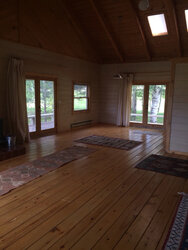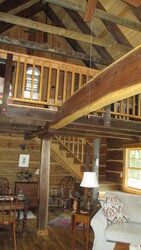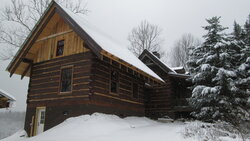Well, that is a good looking cabin, nice looking floors and ceiling.
OK you have 5 1/2 inch thick pine logs, looks like they are pretty tight. Mine is 6 inch pine so we are in the same ballpark. Your walls provide very good insulation.
One thing you ought to do is examine the spaces between the logs. Sometimes you get a little warping.
When it is dark run a flashlight along all of those cracks and have someone outside to see if any light shines through. If so, get some silicone caulk that matches the wall color and caulk any and all cracks, it could add up to a pretty big air leak.
Or, there may be no air leaks in the walls.
Now, let's see if there is any insulation in the ceiling. From the inside, your ceiling looks just like mine with the exposed rafters and decked with pine boards. But, I have R 40 in my ceiling!
Get a drill with a one inch bit. Get one of those flat spade bits, about $7 at Lowes.
Get up there on a ladder inside the house and drill a hole through the ceiling board. Don't do it outside on the roof overhang because there will surely be no insulation on the overhang. That board will either be 3/4 inch thick, or else 1 1/2 inches thick. Just drill right through it.
If there is insulation it probably is foam. Might be pink, might be white or blue. Just drill until you get through the ceiling board and go no deeper.
If you see there is insulation, get a 1/4 inch dowel, or a big 8 inch nail, and shove it into the insulation until it stops. This way you can measure the thickness of the insulation.
Now you have a one inch hole in your ceiling. Buy a one inch dowel rod, cut a 1 inch long piece off of it. Put a little silicone caulk on the side and tap it into place into the hole, until it is flush with the ceiling board, it will look just like a knot hole.
Might be fiberglass insulation up there, you know what that looks like.
Now, if there is no insulation, I would go ahead and try the fierce Jotul out for a winter and see if it works ok.
If not, you can add insulation below the ceiling boards. You would need to use high density foam.
It would be quite a job, I can walk you through it but adding insulation to that house is definitely Plan B.




 While I don't have a cat stove, I've been around here long enough to realize that the tech is still going strong (Blaze King, Woodstock and a few others for example) and many folks that have 'em absolutely love 'em.
While I don't have a cat stove, I've been around here long enough to realize that the tech is still going strong (Blaze King, Woodstock and a few others for example) and many folks that have 'em absolutely love 'em.